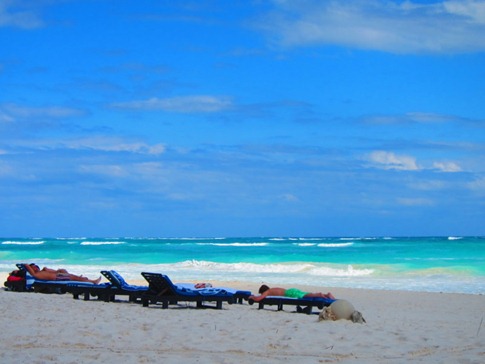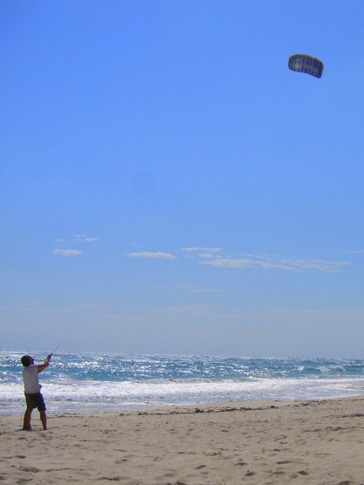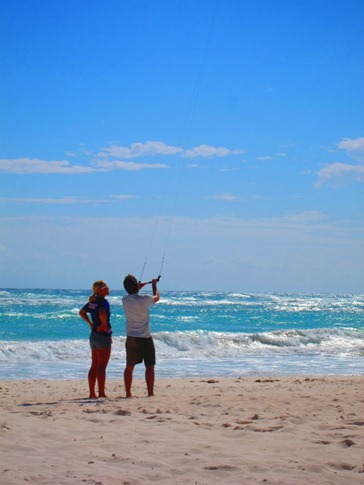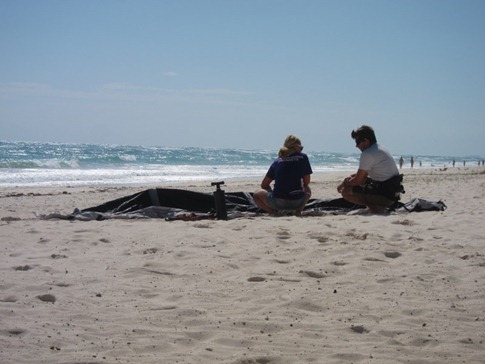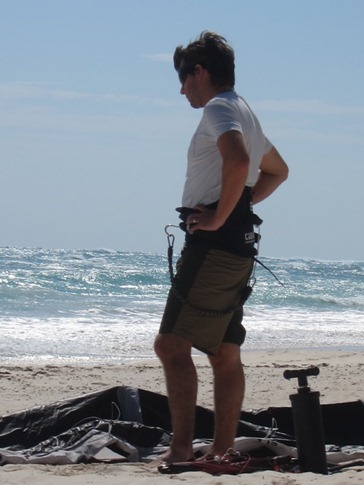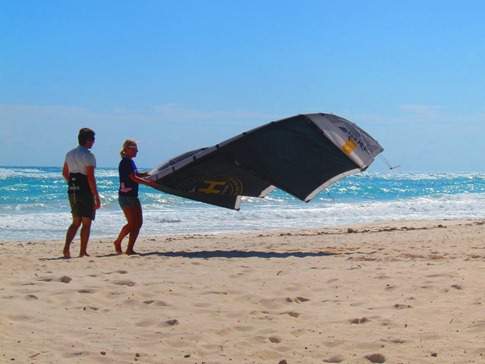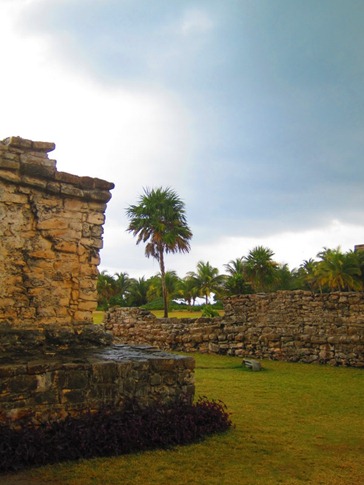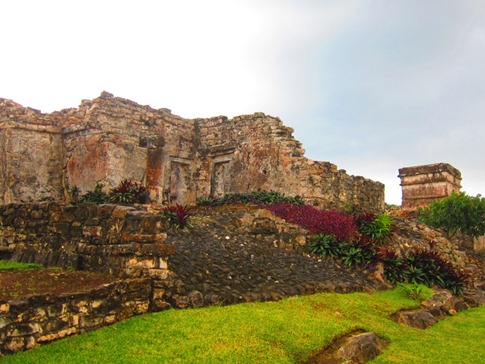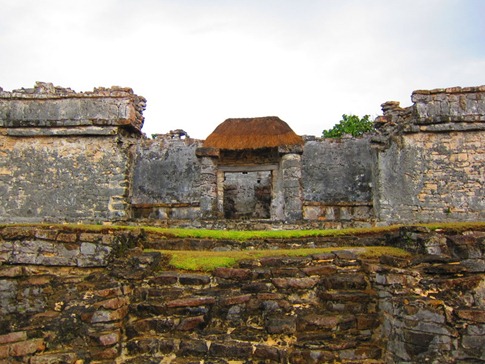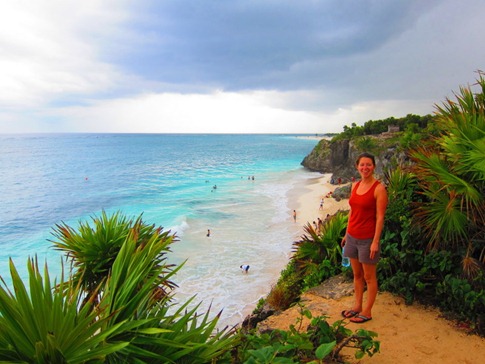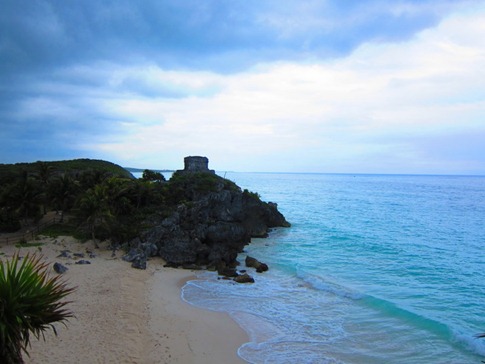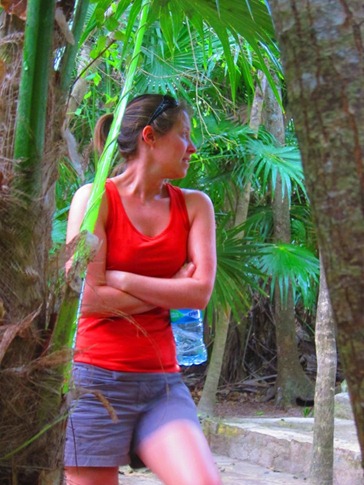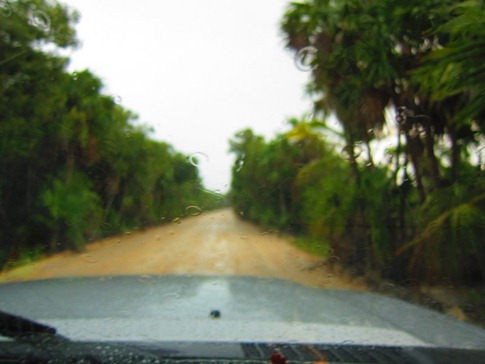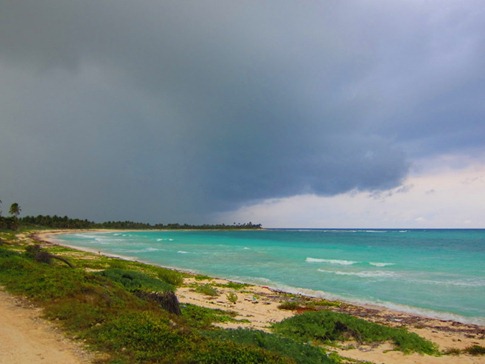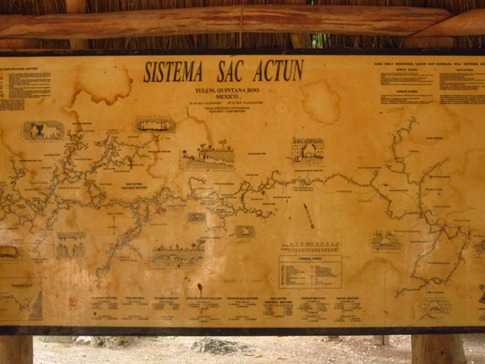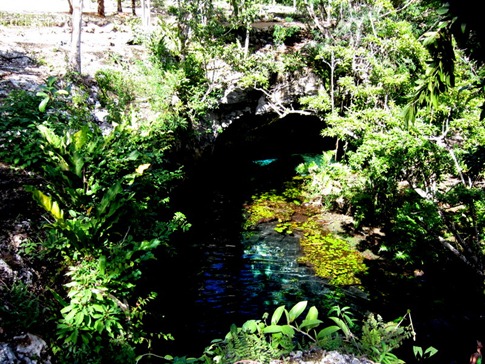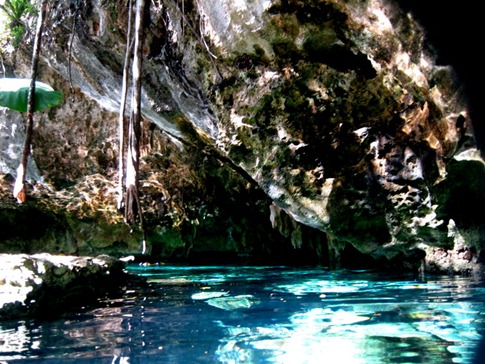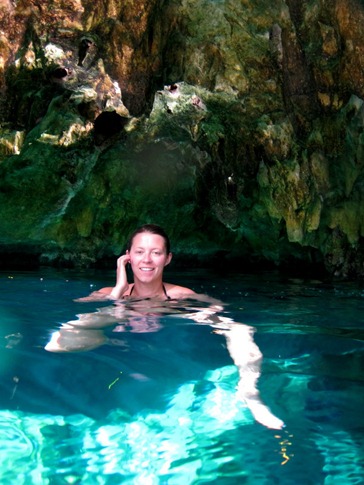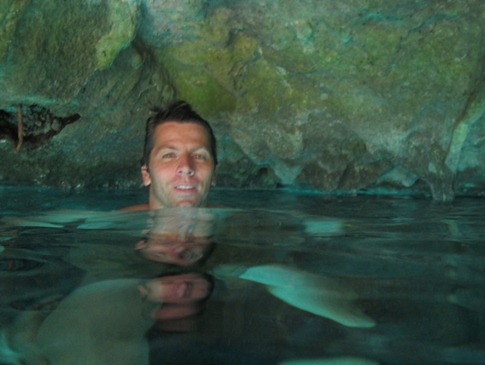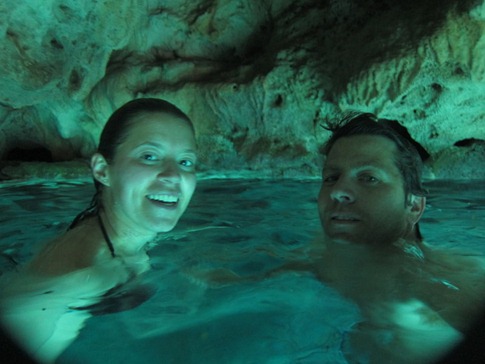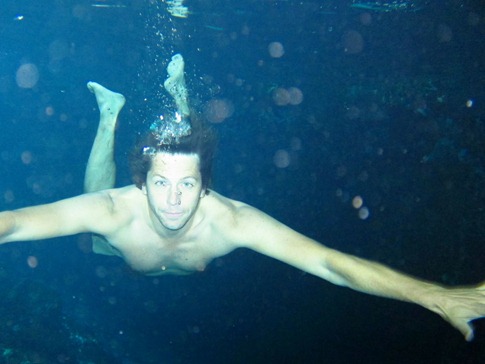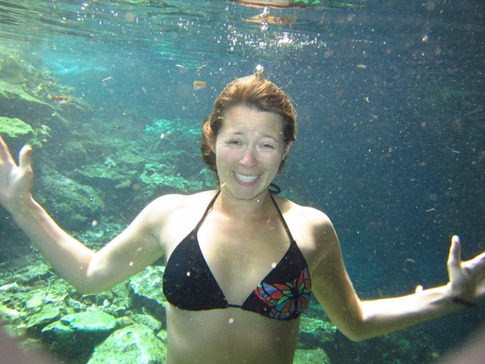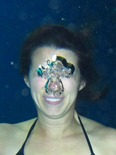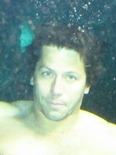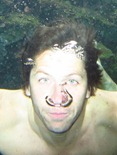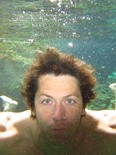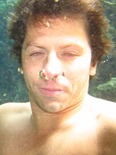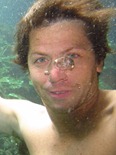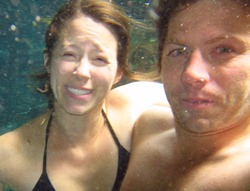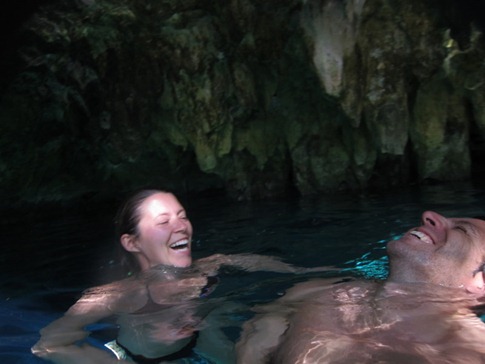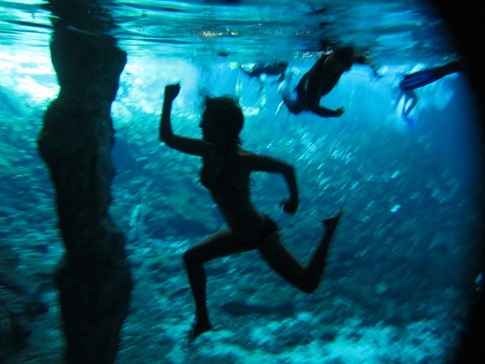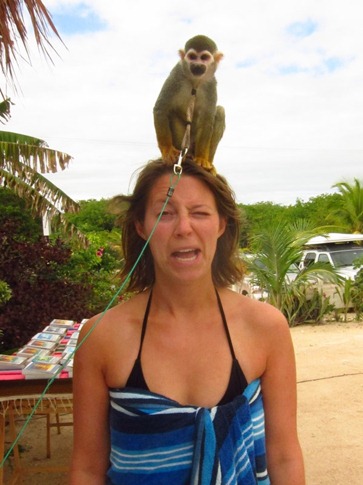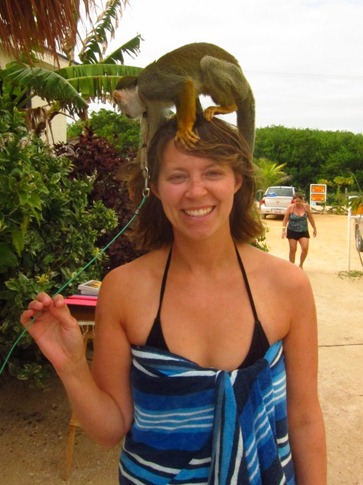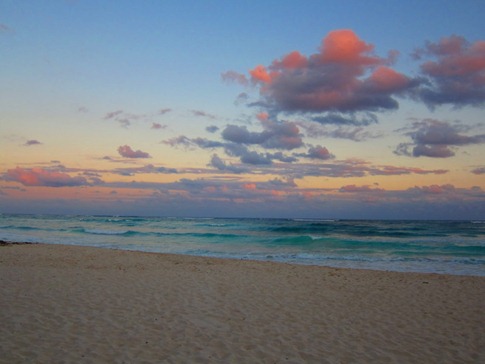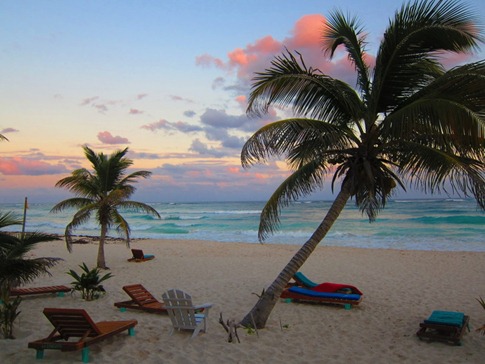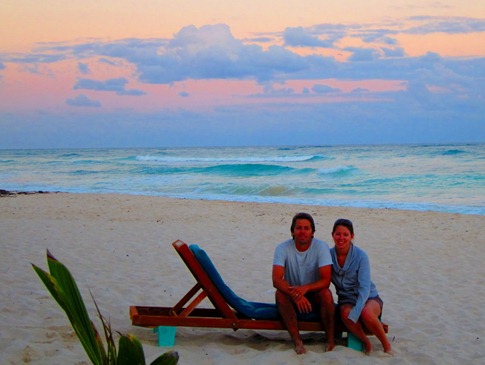The main complaint we’d heard from travelers about the Riviera Maya, the eastern side of the Yucatan Peninsula that faces the Caribbean Sea and includes the vacation destinations of Cancun, Cozumel and Playa del Carmen, was that rampant development meant little or no public beach access or inexpensive camping. From the beginning of the trip, we’d planned a “remember-this-is-sorta-a-honeymoon” splurge in Tulum, a more laid back, eco-friendly alternative to the Club Meds about 100km south of the major resort towns.
Tulum consists of a seaside Mayan ruin, a midsize Mexican town, and a 20km beach road dotted with 5-10 room hotels and “eco-lodges” as it leada towards the Sian Ka’an Biosphere Reserve. We rolled into town with no idea of what was available and made our way down the beach road inquiring anywhere that looked interesting. We saw a few rickety cabanas for decent prices as well as some picture perfect ones with balconies on the beach for WAY more. Most electricity is provided by solar, wind and diesel generators so many places have power only during limited hours, and you have to run down a barrage of questions to figure out exactly what you’re getting.
Each place we stopped seemed to have just one room left, but we couldn’t resist seeing the next one down the road just in case it was a little better (or a little cheaper). Of course, when we determined our favorite and returned for the room, it had just been booked. When it happen again for our second favorite, we jumped on the next place we found, a nice group of cabanas (cabani?) on a small beach bunched in with a few other hotels, restaurants and a convenience store.
Disappointed at not getting our first choice for our Caribbean splurge, I let myself complain for a couple hours about paying these prices for limited electricity and no internet, not liking being so close to the other hotels and generally lamenting the loss of our “authentic Mexico.” Sitting down at the restaurant next door and seeing the cheapest thing on the menu at $30 just about set me off. Ann sat patiently and nodded.
But the next morning, I woke up in paradise. Stunning blue water and white sand on our small, almost private beach; a great breakfast with coffee, fruit and “huevos al gusto” (eggs how you like them) and a super friendly staff; and a pirateable wireless connection from the hotel next door I’d been cursing for it’s proximity. The money was spent and not enjoying it only made it worse.
A guide we’d had on a trip to New Zealand a couple years ago was an avid kite surfer who’d also take his kites to the mountains, strap on a snowboard and go “snow kiting.” In both sports, you enjoy the thrill of the ride while harnessing the power of the wind through an oversize kite attached to your body by a harness. After the trip, I’d bought a 3 meter trainer kite with similar controls to those found on the big ones and had been practicing flying it for 6 months or so. I’d also done some wakeboarding and hoped the skills would translate. A few miles down the beach, I found the kitesurfing school I’d seen in some brochures and signed up for lessons.
As my instructor Lis explained in a heavy German-meets-surfer-chick accent, “Zee kite. He vants to fly.” The trick was understanding what they call a wind window, a clamshell-shaped area downwind where the kite will pick up varying degrees of power. On the periphery of the window, the kite’s leading edge is facing into the wind and most of the force is flowing right past it, but let the kite come inside and the wind catches it like a parachute. This is called the power zone.
Steering on a trainer kite is done by way of two control lines attached to a bar a little like a waterski handle. Pulling the right side of the bar closer to you moves the kite right, and left moves it left. Early control exercises include flying the kite to set positions along the edges of the window. Next, small left and right movements on the control bar fly the kite in a figure 8 motion where you begin to feel the power. Finally a power stroke involves a wide sweeping figure 8 from one edge of the window down through the power zone and across to the other. With my 3 meter kite and a decent wind, a low flying power stroke will pull me two steps forward if I’m not well braced.
So with an 8 meter kite that would be secured to me by way of a harness, there were a few safety procedures to go over to make sure I didn’t end up in Cuba following a stiff gust. After showing me how to fill the inflatable leading edge and struts that help the kite keep its shape in the air and in the water, Lis ran me through “chicken loops,” “donkey dicks” and few other mechanisms designed to either securely attach or quickly detach me from the kite. Thanks to my experience flying my trainer, within an hour I was under the canopy of the big kite and starting to get the feel for its slow, lazy movements; Lazy, that is, until the wind would momentarily falter and the kite would drop down into the power zone. The only way to keep it aloft would be to steer it into a power stroke and hang on for the ride.
The wind died down in the afternoon, and I made arrangements to return the next day to get out into the water, first without the board, to practice some “body drags.” Unfortunately, the wind would not pick up for the next three days and the only body dragging that would be going on was me trying to get Ann to the complimentary breakfast before they cleared it.
While the beachfront scene in Tulum is decidedly sleepy, there’s plenty to do in the surrounding area, and we took an overcast afternoon to see the nearby ruins. When first seen from the water in the 16th century, Spanish explorers reported cities that reminded them of Sevilla. Entering through a passage in the stone wall that protected three sides of the city, we emerged into an open area lined with foundations and remaining walls of fairly modern looking buildings. With a few exceptions, these looked less ceremonial and more practical than others we’d seen including fortress-like structures with prime vantage points out into the ocean. Below the ruins, a small strip of beach could have been a landing spot for canoes traveling the trade route running just inside the reef that spans something like 300km from here down to Honduras.
Overcast turned to tropical downpour as we sought shelter under the living thatch of the jungle canopy.
Later that day, we drove right past our cabana and continued into the Sian Ka’an Biosphere. The potholed, dirt road soon turned to deep puddles as the rain increased, and I may have accidentally tried to get mud on the roof tent a few times. As it stretches for 35km down to the narrow spit called Punta Allen, the road passes thin strips of deserted white sand beaches in between remote jungle compounds and signs for property for sale. These sites were really off the grid and could usually be located by a high tower with a whizzing windmill generating their power. “Just in case,” we wrote down a few of the web site URL’s from real estate companies before turning around towards Tulum.
Gran Cenote is part of the Sistema Sac Atun, a massive series of underground waterways that are a mecca for cave divers from around the world. Unfortunately, every year, experienced divers, many of them only familiar with open water techniques, die in these caves. Passages and rooms have been mapped over the years and given names that remind me of those I’ve seen in rock climbing books -Willy’s Folly, Loop de Loo, Surprise in the Dark - but commonly with more “organic” references – Bills Bowels, Intestinal Alley, Rectum de Diablo. Coincidentally, I just read a story by Tim Cahill called “No Laughs in Satan’s Silt Hole” in his book facetiously titled “Jaguars Ripped My Flesh” that details the ways – silt outs, nitrogen narcosis and entanglements to name a few – cave divers can find themselves in trouble rather quickly.
But while many of these passageways can be connected for miles by experienced divers, Gran Cenote is easily accessible by snorkelers and traveling gringos looking for an excuse to try out the waterproof case for their digital camera.
Turns out, it’s incredibly difficult to pull off a “casual smile” underwater. These are the best…
And this is what we went through to get them. We really recommend that you closely study how bad/creepy the following pictures are…
We decided to hit one more cenote we’d heard about before heading home. The exit for Casa Cenote was 7km north of Tulum and led us down a dirt, coast road fronted with some modest and some incredible beach houses as Ann furiously scribbled down rental and sales info URL’s. While Casa Cenote was a nice swimming hole that looked like it lead into some jungly lagoons, we realized we were a little waterlogged from the underwater photo shoot and started to turn around.
But then I saw it and heard his words echo in my head: “I want a picture of Ann with a monkey.” Our friend Dave had said this to me before we left in one of those “dude-speak” moments where what he might have been trying to say was “Hey man, I’m really gonna miss you guys and know you’ll have all kinds of adventures that I’d love to be a part of so when you’re out there having fun sometimes maybe think about me a little too.” I got the message loud and clear and the guy standing on the beach with a monkey on a leash offering pictures to tourists was my chance to say “We miss you too and want you to feel like part of our adventures.” Or in dude-speak, “Totally bro.”
Before we’d even negotiated the 20 pesos for a picture, the monkey had jumped onto Ann’s shoulder and climbed on top of her head; A picture worth any price. When he came down, we could look more closely as his tiny body, hands smaller than a baby’s and a shrunken little head that reminded me of one of the nut cracker dolls my Mom pulls out of storage every year for Christmas. And to drive the similarity home, when Ann reached to pet his little head, he looked up, grabbed her finger with those two little baby hands, pulled it into his mouth and clenched down on it like a walnut. Ann looked back and forth incredulously from her finger, now bleeding from two fang marks, to the handler who without missing a beat said, “Oh, he doesn’t like to be touched on the head.”
We went home quickly to clean out the bite and assess the damage. I left the room for 15 minutes to see if there might be enough wind to continue my kitesurfing lesson, and by the time I returned, Google had convinced Ann that she now had several monkey-bourn diseases and would soon descend into hallucinogenic jungle madness. I told her I’d shoot her with a tranquilizer dart if she started picking lice off me and agreed to go back the next morning to find the monkey and confirm that he’d been vaccinated (which we did and all was well).
That night we once again picked from among the four or five restaurants within walking distance of our cabana, only two of which didn’t make steam come out of my ears when I saw the prices on the menu. By this time, we were longing to be back in the truck where we could cook our own meals, tired of calculating the amount of time each day we spent waiting for waiters and food and feeling like pushy Americans for asking for the check. A comment that the burger was a little pink spawned a civil but spirited “discussion” about women pointing out problems and men always feeling like they need to solve them that surely didn’t contribute to the romantic evening of the couple sharing our long table.
Tulum was about what we expected: small hotels, beautiful beaches and a laid back vibe. We might have hoped it would be a little more “Mexican,” the ruins, cenotes and the threat of rabies notwithstanding, but once we came to terms with ordering in English, sharing restaurants with gringos and paying beach resort prices, we really enjoyed it and could imagine coming back to either camp on the beach or pony up for the beachfront cabana with a hammock on the balcony.

